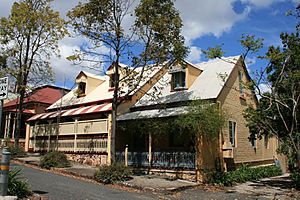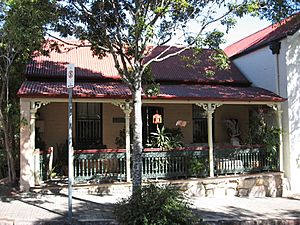Moody's Cottages facts for kids
Quick facts for kids Moody's Cottages |
|
|---|---|

Moody's semi-detached cottages (Cooee and neighbour), 2008
|
|
| Location | 8-12, & 16 Victoria Street, Spring Hill, City of Brisbane, Queensland, Australia |
| Design period | 1870s - 1890s (late 19th century) |
| Built | c. 1875 |
| Official name: Moody's Cottages, Allandoon, Cooee | |
| Type | state heritage (built) |
| Designated | 21 October 1992 |
| Reference no. | 600314 |
| Significant period | 1870s (fabric, historical) |
| Significant components | residential accommodation - maisonette/s / duplex, attic, residential accommodation - main house |
| Lua error in Module:Location_map at line 420: attempt to index field 'wikibase' (a nil value). | |
Moody's Cottages are a group of historic houses in Spring Hill, Brisbane, Australia. They include a duplex (two homes joined together) and a separate house. These buildings were constructed around 1875. They are also known by the names Allandoon and Cooee. Because of their importance to history, they were added to the Queensland Heritage Register on 21 October 1992.
Contents
History of Moody's Cottages
Moody's Cottages were likely built in the mid-1870s. The group includes two semi-detached brick houses, one called Cooee and its unnamed neighbor. There is also a separate brick house named Allandoon.
William Moody, who worked as a letter carrier for the Brisbane Post Office, bought the land in 1870. It is not known if any buildings were already on the property. Moody is listed as living in Victoria Street by 1876.
In September 1874, the property was re-surveyed into three smaller sections. This work was done by Richard Gailey, a well-known Brisbane architect. It is believed that he also designed the cottages.
William Moody and Thomas Spilsbury, a typesetter, signed the survey plan. Spilsbury bought one section from Moody. He then took out a loan, which might have helped pay for building the three houses with Moody. Moody's daughters, Susannah, Hannah, and Margaret Jane, owned the houses until 1949.
In the 1980s, Allandoon was updated and is still a private home. In 1988, the semi-detached houses were changed. They became a house and an art gallery/studio for the artist Rick Everingham. The name Cooee is now generally used for both of these joined houses.
What Moody's Cottages Look Like
The Duplex (Cooee and Neighbor)
Cooee and its neighbor were originally two single-story brick cottages joined together. They had steep, gabled roofs with attic spaces. These attic spaces had windows called dormer windows. The roofs are now made of galvanised iron, but they were probably made of shingles when first built.
The foundations of the houses are made from a type of stone called Brisbane tuff. The outer walls and the wall between the two houses are made of bricks laid on their edge. This was a cheaper way to build and was sometimes used in Brisbane in the 1860s and 1870s.
The houses follow the slope of Victoria Street. The house on the southeastern side is a bit higher than its attached neighbor.
Both houses have narrow front porches (verandahs) right next to the street. These verandahs have curved galvanised iron roofs. They have timber posts with decorative brackets and cast-aluminium railings. The ends of the verandahs are made of brick.
No. 8, the higher and larger house, has a central brick section with four rooms. A hallway leads through the house to a kitchen/dining room and bathroom, which were added later. French doors open from the two front rooms onto the verandah. Inside, the walls are made of brick or pine boards. The cedar doors with fanlights above them are a special feature.
No. 12 is smaller, with two main rooms and an attic bedroom. It has a hallway with a pressed metal ceiling. This hallway leads to the back of the house, where a kitchen, dining room, and bathroom were added later. In 1988, false ceilings were put in the main rooms for track lighting. The house was turned into an art gallery, and the attic room became an artist's studio.
In early 1989, a part of the brick wall between the two houses was removed. This made them into one house and one gallery/studio. Even with some changes, these former semi-detached houses still look much like they did. They are a rare type of housing in Brisbane.
Allandoon
Allandoon is a small, single-story brick house. It is shaped like a rectangle and has a gabled roof made of corrugated iron. This roof was probably made of shingles when the house was new.
Its foundations are also made of Brisbane tuff. The oldest part of the building uses the same brick-laying technique as the semi-detached cottages.
A narrow front verandah is right next to the street. It has a curved corrugated iron roof, timber posts, decorative brackets, and cast-aluminium railings. The ends of the verandah are made of brick.
Inside, the house has four main rooms that open off a central hallway. A kitchen, dining area, and bathroom were added to the back of the house later. The outside of the house facing the street looks mostly original and is painted in traditional colors.
Why Moody's Cottages Are Important
Moody's Cottages were listed on the Queensland Heritage Register on 21 October 1992. This means they are considered important because of their history and special features.
They show how Queensland's history developed. Moody's Cottages are important because they show how Spring Hill grew into a residential area in the 1860s and 1870s.
They are rare examples of Queensland's heritage. These cottages are unusual examples of brick homes built for working-class families in Brisbane during the 1870s. They are even rarer because of how they were built with brick and stone, and their gable style. They are a rare example of brick, semi-detached working-class housing from the 1870s in Brisbane.
They show key features of their type of building. They are a rare example of brick, semi-detached working-class housing from the 1870s in Brisbane.
They have aesthetic value. The cottages are beautiful and add to the look of the street. They are a key part of the historic area around Victoria and Rogers Streets in Spring Hill.


